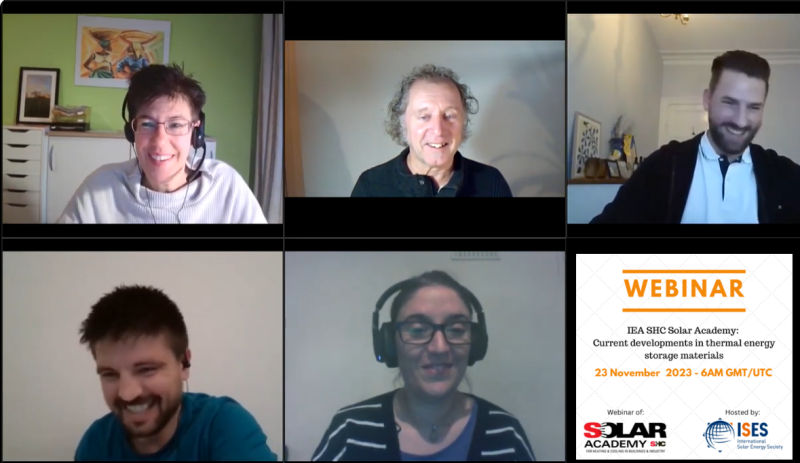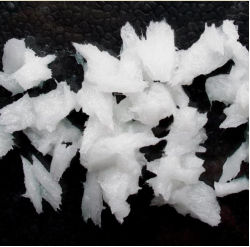Posted: December 29, 2023

The Compact Thermal Energy Storage group within the IEA Solar Heating and Cooling programme investigates new materials for storing heat and develops standard procedures to test their stability, heat capacity etc. This is important basic research in order to find storage materials for new applications. During the Solar Academy webinar in mid-November 2023, four researchers from IEA SHC Task 67 presented their research results. The participants also wanted to know which materials are currently used in series products and which "champions of PCMs and TCMs" the scientists have already found in their investigations. In this post we describe some marketable products and the speakers' answers. The screenshot was taken during the Q&A session of the IEA SHC Webinar on Current Developments in Thermal Energy Storage Materials (full recording available here). https://www.iea-shc.org/solar-academy/webinar/thermal-energy-storage-materials
Wim van Helden, Co-Chair of Task 67, said during the Q&A session that especially in the field of phase-change materials (PCMs) there are already market-ready products available. He specifically highlighted the Scottish storage tank manufacturer Sunamp, which uses an inorganic material based on salt hydrate (sodium acetate hydrate). The material P58 changes phase at 58 °C, which is good for domestic hot water and space heating applications. According to the company's website, the storage tank series filled with P58 has been commercially available since 2018 under the name Thermino.
Zeolites in dishwashers reduce the energy demand by 20 %
Van Helden also emphasized the fact that in the field of thermochemical storage materials zeolites are used in a growing number of dishwashers to increase their efficiency. Zeolite pebbles look like small, greenish-beige stones. They extract water from their surroundings, while releasing a significant amount of heat. The German manufacturer Bosch uses zeolites in a dishwasher series called PerfectDry and claims to save 20 % of the energy needed for each wash cycle. Zeolites use the moisture from the cleaning phase to generate hot air, which is used for drying the dishes.

Rubitherm has developed a low-flammable class of PCM consisting of a unique composition of inorganic components such as different salts Photo: Rubitherm
PCMs have up to 5 times more thermal capacity than water
German storage tank manufacturer Rubitherm offers a wide portfolio of thermal storage tanks for residential applications using PCMs. The company uses both inorganic PCMs (mixtures of different salts and water) and organic PCMs (produced from vegetable oils or fossil oil). Rubitherm has shown that PCM storage tanks can be designed for a wide range of temperatures. The inorganic PCMs produced in-house melt at temperatures between -21 °C and 90 °C. The materials can therefore be used for cooling, air conditioning and heating applications. Heat capacities are between 150 and 300 kJ/kg at a working temperature difference (delta T) of 15 K. Water as a storage material has a capacity of 63 kJ/litre. In the best-case scenario, the PCM-filled storage tanks can therefore be five times smaller than water storage tanks.
When asked about the cycle stability of their PCM materials, Andreas Lärz, Product Manager at Rubitherm, said that several thousand cycles are guaranteed for their organic PCMs, and up to 10,000 cycles have been tested for specific inorganic PCMs.
Rubitherm joined some of the Task 67 meetings at the beginning as “we are interested in following up on all developments focusing on PCMs”, explained Lärz. The company wants the IEA SHC Task 67 to develop standardized measurement procedures for compact thermal energy storage tanks and not just for materials.
Finally, van Helden assessed the various PCMs as follows: Inorganic PCMs are generally cheaper and have a higher melting enthalpy per kilogram than organic PCMs. But they also corrode metals, so that they need to be encapsulated in the tank to protect the metal heat exchangers. Alternatively, polymeric heat exchangers need to be used. Due to their higher price, organic PCMs are more often applied in high-end applications with higher added value.
There are no champions of PCMs and TCMs
During the Q&A session one of the webinar participants challenged the speakers by asking: “Where are the results of all the testing to determine the champions for PCM and thermochemical material (TCM)? It would save a lot of time if the best material were selected using the generated data.”
“There are no champions,” Angel Serrano Casero, Researcher from the Spanish Institute CIC EnergiGUNE, made clear. “We cannot say that one PCM or one TCM is the best, because we need to take into account the application. And when I say the application, it is not only the properties of the material; you also need to consider the cost.”
Van Helden agreed with his colleague but gave a slightly different explanation in his answer: “It is not our task to find champions. Our task is much more to develop procedures and methods with which champions can be identified depending on the application.” He has seen that from time to time a group of researchers detaches from the international task network and uses its personal champion in order to work on prototypes and on new products.
When asked about the champions, Gerald Englmair from the Technical University of Denmark recalled that there are a lot of new applications coming up due to energy transition, for example high-temperature industrial heat or server room cooling. So he thinks it is important in research to remain open to these new applications and to develop and test various materials simultaneously.
If you would like more information about the state of the art and an outlook on compact thermal energy storage, you can read the Technology Position Paper published in June 2023. On seven pages, some promising possible applications are described in a compact manner and actions are listed that are necessary to tap into the potential.
IEA_SHC_Technology_Position_Paper_Compact_Thermal_Energy_Storage_June2023.pdf (iea-shc.org)
Websites of organizations mentioned in this news article: